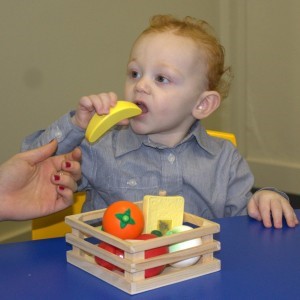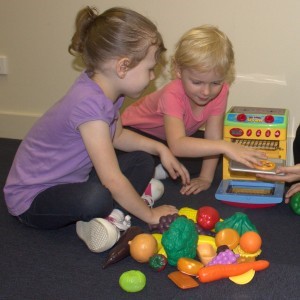 Sometimes children can be fussy eaters and reluctant to try new foods. There are many reasons why children may refuse certain foods including the way the food looks or the feel of the food on the child’s hands or in their mouth. Children might find certain foods more difficult to chew or think the food is boring or uninteresting. Children with special needs such as autism spectrum disorder can be especially fussy eaters. Below are some ideas for supporting children to learn to eat a wider range of foods.
Sometimes children can be fussy eaters and reluctant to try new foods. There are many reasons why children may refuse certain foods including the way the food looks or the feel of the food on the child’s hands or in their mouth. Children might find certain foods more difficult to chew or think the food is boring or uninteresting. Children with special needs such as autism spectrum disorder can be especially fussy eaters. Below are some ideas for supporting children to learn to eat a wider range of foods.
If your child has significant difficulties with eating it is useful to seek professional support. Talking Matters runs fussy eating groups in school holidays run by professionals trained in SOS feeding, an evidence based way of supporting children with sensory and oral motor based feeding difficulties.
Here are some tips for fussy eaters:
Avoiding further reductions in preferred foods. Kids who are problem eaters often eat a limited range of foods and want to eat the same foods over and over. Often parents are happy to give them the same food as they eat a limited range anyway and parents are relieved to get them just to eat. The only problem is that if food is repeated too often your child will eventually tire of it and your child's list of foods will get even smaller.
Here is how you can prevent losing foods from your child's list:
Offer foods no more often than every second day. Make a list of all the things your child eats. Include different presentations as different foods, for example if your child eats vanilla yoghurt and strawberry yoghurt that counts as two foods. If you child eats mashed potato, roast potato and hot potato chips that counts as three foods.
Once you have a list, check you have enough foods for two full days, for three meals and two snacks. Plan out your child's meals so that no food is repeated within the two days. Don't worry if you have to mix foods typically eaten for certain meals, such as have breakfast food for lunch or dinner foods for snacks; it is the variety that is important.
If your child does not have enough foods for two full days you will need to make small changes to their preferred foods, by changing one sensory property of the food (shape, colour, taste, texture or temperature). Stick with the one change for a week then add another small change. See below for ideas on how to do this.
To expand the range of foods your child eats try to change at least one sensory property of a preferred food each time you give it to your child. Stick with that change for a week then introduce a new change. You can change a food by shape, colour, taste, texture or temperature. The best order for changes is:
- shape,
- colour,
- taste
- texture or temperature
 Here are some ideas for changes you can make:
Here are some ideas for changes you can make:
- Change the Shape: Cut the food into different sizes or shapes to the way your child usually has it. You can use peelers, graters, slicers, choppers or cookie cutters.
- Change the Colour: Add a little food colouring to preferred foods. Some foods can be bought in different colours without changing the flavour or texture, such as cherry tomatoes and apples. At this stage avoid changes that also change the flavour of the food.
- Change the Taste: Add a new flavour such as spices, herbs, extra butter, Parmesan cheese, flavoured syrup, jam, soy sauce, tomato sauce, jelly crystals, gravy or dried soup powders.
- Change the Texture: Thicken foods with cornflour, add an extra egg when cooking, add extra oil to cooking mixtures or cook the food in a different way(e.g. fried, scrambled or poached or boiled eggs, potatoes mashed, boiled, roasted, as wedges or chips).
Aim for a just noticeable difference. Some children notice and are upset by very small changes and may refuse to try foods that have been changed. Make changes small so that your child notices the change but is still willing to eat. If your child is distressed make smaller changes next time.
Here are some other ideas to encourage fussy children to eat new and different foods:
Involve your child in the kitchen. Involving children in the kitchen can be a great way to make them feel included and to spark an interest in their food. For children with motor control and planning difficulties, getting involved in food preparation can give their brains more time to think about eating and start planning and what the muscles of the body will need to do when the food is ready.
Allowing children to help in the kitchen can be as simple as allowing them to choose what shape or type of spaghetti to cook, or getting your child to put some chopped vegetables in a saucepan ready to cook. Children can also help gathering ingredients and equipment from cupboards, washing fruits and vegetables, measuring, mixing and adding ingredients, and if you are doing some baking children can help with rolling, kneading and icing.
Older children might be able to help with chopping or grating foods as well. Be sure to supervise younger cooks in the kitchen and expect some spills and messes. Don’t forget to include children in the cleaning up afterwards and remember that good cooks of all ages need to wash their hands before they start cooking.
Give your child choices about what they eat. Like adults, children enjoy making decisions about what they eat and letting your child make small choices about their food can help them feel like they have some control over what they eat. You might include your child in a decision about what to cook for dinner (e.g. spaghetti bolognaise or chicken stir fry) or it might be smaller decisions about the ingredients. For example, your child could decide whether to have carrot or capsicum in the stir fry, or whether to have long thin spaghetti or macaroni with the bolognaise sauce. Giving children a choice between 2 or 3 options gives them some control but allows you to still cook and serve meals that your family enjoy.
Present the food in new and exciting ways. Start to think about how to present food in new and exciting ways, particularly if you are introducing new foods or encouraging children to eat foods they are reluctant to eat! This can include changing what you use to hold the food and what you use to eat the food.
Ideas include:
- Serving a small portion of the food in the corner of an ice cube tray
- Serving a small portion of food in a large Asian soup spoon
- Serving food in bowls made for dips and biscuits that are divided into sections
- Using fun lunch boxes with compartments to serve meals, even breakfast or dinner at home
- Using non-food containers to serve food such as test tubes, old jars
- Using different knives, forks, and spoons or even try using something different to eat with like chop sticks!
 You can also make food more exciting by changing the way you prepare or cook familiar foods.
You can also make food more exciting by changing the way you prepare or cook familiar foods.
Ideas include:
- Using food dye to change the colour of custards, sauces and yoghurts
- Cutting sandwiches into different shapes using biscuit cutters
- Looking for different brands, shapes and sizes of familiar food when you go shopping such as different shapes of pasta
It does not have to be expensive or time consuming, so start looking around for simple ideas to liven up meal times!
Give your child opportunities to change the texture of difficult foods. If your child does not like certain foods or will not try foods because they think it will be too difficult to eat and chew; look for ways to change the texture of the food.
For example:
- Adding extra sauces, custards, yoghurts, creams or gravies to food
- Helping your child use a potato masher or rolling pin to mash, roll or crush food
- Putting the food in a blender or a small food processor/chopper for a few seconds
If you are encouraging your child to try more difficult textures then let them add more sauce or change the texture of their food after they try at least a certain amount (e.g. 3 spoonfuls). You might also use the rule that any food your child chops, mashes, rolls or crushes then they must also eat it.
Allow or help children to serve themselves. Sometimes children can refuse to try food altogether if they feel there is too much on their plate and cannot imagine being able to eat all of it. Giving children some control over the amount of food that goes on their plate can make new food or food they do not like appear less threatening. You can do this by putting food in the middle of the table and allowing people to serve themselves, or you can let your child help you put food on everyone’s plates before you bring them out to the table. You can set rules around the minimum amount of food that must go on their plate but then let them decide how much more. For example, your child must put a least one tablespoon of peas on their plate but can decide if and how many more peas to have.
Try to make meal times fun and enjoyable! While everyone is eating, talk about the meal including the temperature, smell, appearance, taste (e.g. sour, sweet, spicy, etc.) and texture (e.g. crunchy, running, soft, smooth, etc.). Talk about what you like about the meal.
Age appropriate ideas for including children in the kitchen
Two-year-olds are learning to use the large muscles in their arms. They will enjoy activities such as:
- scrubbing vegetables and fruits
- wiping tables
- dipping vegetables and fruits
- tearing lettuce and salad greens
- breaking bread for stuffing
- snapping fresh beans
Three-year-olds are learning to use their hands. Try activities such as:
- pouring liquids into a batter
- mixing muffin batter
- shaking a milk drink
- spreading peanut butter on firm bread (This may be messy!)
- kneading bread dough
Four- and five-year-olds are learning to control smaller muscles in their fingers. Offer them experiences such as:
- rolling bananas in cereal for a snack
- juicing oranges, lemons, and limes
- mashing soft fruits and vegetables
- measuring dry and liquid ingredients
- grinding cooked meat for a meat spread
- beating eggs with an eggbeater
If you are concerned about your child's development including speech, language, play skills, social communication skills, social skills or learning check our website to see how Talking Matters may be able to help. For more ideas and resources check the resources section on our website and our extensive Pinterest page. Like us on Facebook and follow us on Twitter so you don't miss out on what's happening.
If you are concerned about your child's skills Talking Matters provides speech pathology and occupational therapy. To find out more about Talking Matters and our services and resources check our website or call our office on (08) 8255 7137.
Related Blog Posts
If you liked this post you may also like:
Using LET'S GO FISHING To Grow
Following Daily Routines
ASD FAQ
10 Tips for HFA



